Grid Stability and Wind Energy Integration Analysis on the Transmission Grid Expansion Planned in La Palma (Canary Islands)
Abstract
1. Introduction
2. Theoretical Background
2.1. Current Electrical Grid
2.2. REE Horizon Energy Plan (2026) Reinforcement of La Palma Grid
3. Materials and Methods
3.1. Simulation Tool Used—PSS®E (v34)
| System | Model | Description |
|---|---|---|
| Diesel generation units | ||
| Generator | GENSAL | The model represents a salient pole synchronous generator with quadratic saturation in d-axis. |
| Turbine governor | DEGOV | DEGOV model is used to represent diesel engine governors, for transient modeling studies of diesel electric generators [50]. |
| Excitation system | EXBAS | The EXBAS model represents an AC excitation standard system with rotating diodes and non-controlled rectifiers [4]. |
| Wind turbines—Type I | ||
| Generator | WT1G1 | This model is used to represent induction generators of fixed-speed wind turbines [51] directly connected to the grid. It considers rotor flux dynamics and can be used for single and double cage machines. |
| Mechanical model | WT12T1 | The WT12T1 model computes the speed deviations produced on the rotor and on blade sides of the wind turbine [51]. |
| Wind turbines—Type IV | ||
| Generator | REGCA1 | The REGCA1 model was developed to simulate a wind generator connected to the grid via power converter (full-variable speed) [49]. This module incorporates a current regulator that injects real and reactive current based on current commands. |
| Electrical control | REECA1 | REECA1 emulates active and reactive power controls implemented in the wind turbine converter. It provides alternatives for active power control (constant power factor) and reactive power reference [49]. |
3.2. Grid Model Development
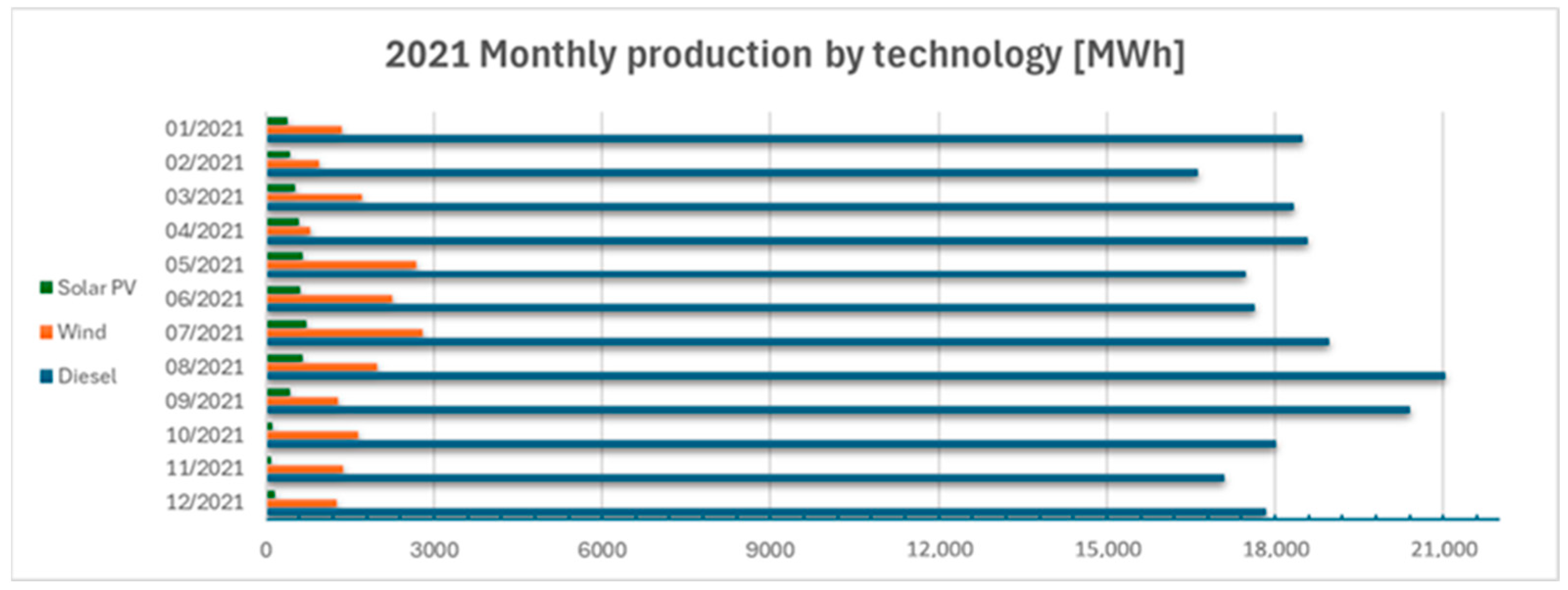
3.3. Simulation Scenarios
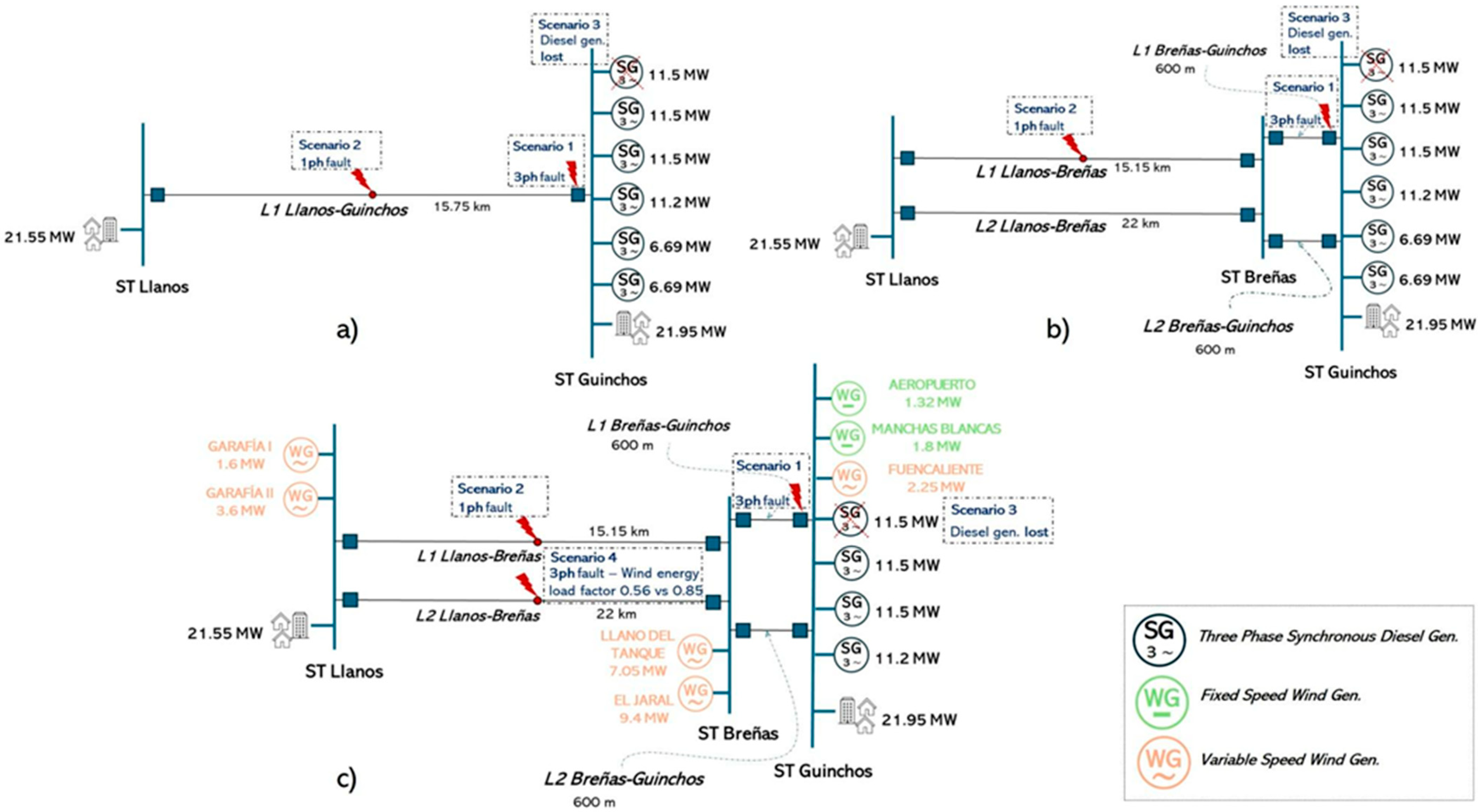
3.3.1. Steady State
3.3.2. Scenario 1—Three-Phase Fault on Substation Busbar
3.3.3. Scenario 2—Single-Phase Fault in the Middle of the Line
3.3.4. Scenario 3—Loss of a Diesel Unit
3.3.5. Scenario 4—Loss of a Wind Unit
4. Results
4.1. Steady State
4.2. Scenario 1
4.3. Scenario 2
4.4. Scenario 3
4.5. Scenario 4
5. Conclusions
Author Contributions
Funding
Data Availability Statement
Conflicts of Interest
Abbreviations
| EC | European Commission |
| LF | Load Factor |
| OPF | Optimal Power Flow |
| REE | Red Eléctrica de España |
| WECC | Western Electricity Coordinating Council Modeling and Validation Work Group |
Appendix A
| Model | Parameter | Value |
|---|---|---|
| GENSAL | H | 4.7436 |
| GENSAL | D | 0.01326 |
| GENSAL | Xd | 0.01371 |
| GENSAL | Xq | 2 |
| GENSAL | X’d | 0 |
| GENSAL | X’q | 2.597 |
| GENSAL | T’do | 1.1949 |
| GENSAL | T’qo | 0.1761 |
| GENSAL | S(1.0) | 0.1284 |
| GENSAL | S(1.2) | 0.1 |
| GENSAL | Ra | 0.07 |
| GENSAL | Xl | 0.33 |
| EXBAS | TR | 0.011 |
| EXBAS | KA | 0.576 |
| EXBAS | TA | 2.88 |
| EXBAS | VRmax | 424 |
| EXBAS | VRmin | 0.036 |
| EXBAS | KE | 0.01 |
| EXBAS | TE | 0.01 |
| EXBAS | KF | 11.1 |
| EXBAS | TF | −11.1 |
| EXBAS | AEC | 0.0125 |
| EXBAS | TE_B | 0.075 |
| EXBAS | VBmax | 0.01 |
| EXBAS | RC | 0.5 |
| EXBAS | XC | 1 |
| EXBAS | KLR | 0.3 |
| EXBAS | TLR | 0.01 |
| EXBAS | ILR | 0.2 |
| EXBAS | Rex | 3.5 |
| EXBAS | Rfd | 0.15 |
| DEGOV1 | R | 1 |
| DEGOV1 | T1 | 0.019 |
| DEGOV1 | T2 | 0.0053 |
| DEGOV1 | T3 | 1.6 |
| DEGOV1 | FHP | 15 |
| DEGOV1 | FLP | 0.3 |
| DEGOV1 | K | 0.011 |
| DEGOV1 | T4 | 0.185 |
| DEGOV1 | Pmax | 0.1 |
| DEGOV1 | Pmin | 0.8 |
| DEGOV1 | T5 | 0 |
| DEGOV1 | DT | 0.06067 |
| DEGOV1 | GV1 | 0.5 |
| Model | Parameter | Value |
|---|---|---|
| WT1G1 | J | 0.846 |
| WT1G1 | J’’ | 0 |
| WT1G1 | X | 3.927 |
| WT1G1 | X’ | 0.1773 |
| WT1G1 | X’’ | 0 |
| WT1G1 | Xl | 0.1 |
| WT1G1 | E1 | 1 |
| WT1G1 | S(E1) | 0.03 |
| WT1G1 | E2 | 1.2 |
| WT1G1 | S(E2) | 0.179 |
| WT12T1 | H | 5.3 |
| WT12T1 | DAMP | 0 |
| WT12T1 | Htfrac | 0.918 |
| WT12T1 | Freq1 | 5 |
| WT12T1 | Dshaft | 1 |
| REGCA1 | Tfltr | 0.01–0.02 s |
| REGCA1 | Lvpl1 | 1.1–1.3 |
| REGCA1 | Zerox | 0.4 |
| REGCA1 | Brkpt | 0.9 |
| REGCA1 | Lvplsw | 0 |
| REGCA1 | rrpwr | 10.0 pu/s |
| REGCA1 | Tg | 0.02 s |
| REGCA1 | Volim | 1.2 pu |
| REGCA1 | Iolim | −1.0 to −1.5 pu |
| REGCA1 | Khv | 0.7 |
| REGCA1 | lvpnt0 | 0.4 |
| REGCA1 | lvpnt1 | 0.8 |
| REGCA1 | Iqrmax | 999.9 pu/s |
| REGCA1 | Iqrmin | −999.9 pu/s |
| REECA1 | Vdip | 0.85–0.9 pu |
| REECA1 | Vup | 1.2 |
| REECA1 | Trv | 0.01–0.02 s |
| REECA1 | dbd1 | −0.1–0 pu |
| REECA1 | dbd2 | 0–0.10 pu |
| REECA1 | Kqv | 0–10 pu/pu |
| REECA1 | Iqh1 | 1.0–1.1 pu |
| REECA1 | Iql1 | −1.1–1.0 pu |
| REECA1 | Vref0 | 0.95–1.05 pu |
| REECA1 | Iqfrz | −0.1–0.1 pu |
| REECA1 | Thld | −1–1 s |
| REECA1 | Thld2 | 0 s |
| REECA1 | Tp | 0.01–0.1 s |
| REECA1 | Qmax | 0.4–1.0 pu |
| REECA1 | Qmin | −1.0 to −0.4 pu |
| REECA1 | Vmax | 1.05–1.1 pu |
| REECA1 | Vmin | 0.9–0.95 pu |
References
- European Commission. EU Leads Global Initiative at COP28 to Triple Renewable Energy Capacity and Double Energy Efficiency Measures by 2030. Available online: https://ec.europa.eu/commission/presscorner/detail/en/ip_23_6053 (accessed on 12 April 2024).
- Kaya, O.; van der Roest, E.; Vries, D.; Keviczky, T. Hierarchical Model Predictive Control for Energy Management of Power-to-X Systems. In Proceedings of the 2020 IEEE PES Innovative Smart Grid Technologies Europe (ISGT-Europe), The Hague, The Netherlands, 26–28 October 2020; pp. 1094–1098. [Google Scholar] [CrossRef]
- Gils, H.C.; Simon, S. Carbon neutral archipelago—100% renewable energy supply for the Canary Islands. Appl. Energy 2017, 188, 342–355. [Google Scholar] [CrossRef]
- Merino, J.; Veganzones, C.; Sanchez, J.A.; Martinez, S.; Platero, C.A. Power System Stability of a Small Sized Isolated Network Supplied by a Combined Wind-Pumped Storage Generation System: A Case Study in the Canary Islands. Energies 2012, 5, 2351–2369. [Google Scholar] [CrossRef]
- Lemus, R.G. Back in the Race: Achieving 100% Renewable Energy in the Canary Islands. IEEE Power Energy Mag. 2020, 18, 64–74. [Google Scholar] [CrossRef]
- Connolly, D.; Mathiesen, B.V. A technical and economic analysis of one potential pathway to a 100% renewable energy system. Int. J. Sust. Energy Plan. Manag. 2014, 1, 7–28. [Google Scholar] [CrossRef]
- Katsaprakakis, D.A.; Papadakis, N.; Kozirakis, G.; Minadakis, Y.; Christakis, D.; Kondaxakis, K. Electricity supply on the island of Dia based on renewable energy sources (R.E.S.). Appl. Energy 2009, 86, 516–527. [Google Scholar] [CrossRef]
- Krajačić, G.; Duić, N.; Carvalho, M.d.G. H2RES, Energy planning tool for island energy systems—The case of the Island of Mljet. Int. J. Hydrogen Energy 2009, 34, 7015–7026. [Google Scholar] [CrossRef]
- Cabrera, P.; Lund, H.; Carta, J.A. Smart renewable energy penetration strategies on islands: The case of Gran Canaria. Energy 2018, 162, 421–443. [Google Scholar] [CrossRef]
- Ramirez-Diaz, A.; Ramos-Real, F.J.; Marrero, G.A. Complementarity of electric vehicles and pumped-hydro as energy storage in small isolated energy systems: Case of La Palma, Canary Islands. J. Mod. Power Syst. Clean Energy 2016, 4, 604–614. [Google Scholar] [CrossRef]
- Padrón, S.; Medina, J.F.; Rodríguez, A. Analysis of a pumped storage system to increase the penetration level of renewable energy in isolated power systems. Gran Canaria: A case study. Energy 2011, 36, 6753–6762. [Google Scholar] [CrossRef]
- Schallenberg-Rodríguez, J.; García Montesdeoca, N. Spatial planning to estimate the offshore wind energy potential in coastal regions and islands. Practical case: The Canary Islands. Energy 2018, 143, 91–103. [Google Scholar] [CrossRef]
- Qiblawey, Y.; Alassi, A.; Zain ul Abideen, M.; Bañales, S. Techno-economic assessment of increasing the renewable energy supply in the Canary Islands: The case of Tenerife and Gran Canaria. Energy Policy 2022, 162, 112791. [Google Scholar] [CrossRef]
- Magallones, T.G.; Singh, J.G. Impact of interconnections and renewable energy integration on the Philippine–Sabah Power Grid systems. Glob. Energy Interconnect. 2023, 6, 253–272. [Google Scholar] [CrossRef]
- Alves, M.; Segurado, R.; Costa, M. Increasing the penetration of renewable energy sources in isolated islands through the interconnection of their power systems. The case of Pico and Faial islands, Azores. Energy 2019, 182, 502–510. [Google Scholar] [CrossRef]
- Europa Press. La Isla de la Palma Sufre un Apagón General Tras una Avería. Available online: https://www.elcorreo.com/vizcaya/rc/20130903/sociedad/isla-palma-apagon-201309031836.html (accessed on 15 March 2024).
- La Palma Ahora. Endesa ha Ejecutado ya el 70% de las Actuaciones para Reconstruir el Doble Anillo Eléctrico de La Palma Destruido por el Volcán. Available online: https://www.eldiario.es/canariasahora/lapalmaahora/economia/endesa-ejecutado-70-actuaciones-reconstruir-doble-anillo-electrico-palma-destruido-volcan_1_10604438.html (accessed on 3 April 2024).
- E-Distribución. E-Distribución Comienza el Plan de Reconstrucción Eléctrica de La Palma con dos Centrales Térmicas Portátiles. Available online: https://www.endesa.com/es/prensa/sala-de-prensa/noticias/clientes/endesa-comienza-plan-de-reconstruccion-electrica-de-la-palma-con-dos-centrales-termicas-portatiles (accessed on 25 July 2025).
- Miyara, R.; Prabaharan, N.; Rangarajan, S.S.; Collins, E.R.; Takahashi, H.; Omine, E.; Senjyu, T. A virtual synchronous generator control method for remote island power system considering dynamic voltage stability. Energy Rep. 2023, 9, 1041–1049. [Google Scholar] [CrossRef]
- Padrón, S.; Hernández, M.; Falcón, A. Reducing Under-Frequency Load Shedding in Isolated Power Systems Using Neural Networks. Gran Canar. A Case Study. IEEE Trans. Power Syst. 2016, 31, 63–71. [Google Scholar] [CrossRef]
- Ameur, A.; Loudiyi, K.; Aggour, M. Steady State and Dynamic Analysis of Renewable Energy Integration into the Grid using PSS/E Software. Energy Procedia 2017, 141, 119–125. [Google Scholar] [CrossRef]
- Rajabdorri, M.; Kazemtabrizi, B.; Troffaes, M.; Sigrist, L.; Lobato, E. Inclusion of frequency nadir constraint in the unit commitment problem of small power systems using machine learning. Sustain. Energy Grids Netw. 2023, 36, 101161. [Google Scholar] [CrossRef]
- Egido, I.; Sigrist, L.; Lobato, E.; Rouco, L.; Barrado, A. An ultra-capacitor for frequency stability enhancement in small-isolated power systems: Models, simulation and field tests. Appl. Energy 2015, 137, 670–676. [Google Scholar] [CrossRef]
- Instituto Tecnológico de Canarias. Clean Energy for EU Islands: Estudio Técnico y Económico de Centrales de Bombeo Reversible. La Palma, Spain; Instituto Tecnológico de Canarias: Gran Canaria, Spain, 2023. [Google Scholar]
- Eliassi, M. Virtual Transmission Line for N-1 Security Compliance with Storage: Case of La Palma, Spain; 3E: Brussels, Belgium, 2022. [Google Scholar]
- Clean Energy for EU Islands Secretaria. The Benefits of New 66kV Overhead Line in La Palma: Identifying and Analysing Technical Values of Investments; Clean Energy for EU Islands Secretaria: Brussels, Belgium, 2020. [Google Scholar]
- Red Eléctrica de España (REE). Plan de Desarrollo de la Red de Transporte de Energía Eléctrica: Período 2021–2026; REE: Madrid, Spain, 2022. [Google Scholar]
- Red Eléctrica de España (REE). Planificación Vigente 2021–2026. Available online: https://www.planificacionelectrica.es/planificacion-vigente (accessed on 20 April 2024).
- Instituto Nacional de Estadística. Censo Anual de Población 2021–2024. Available online: https://www.ine.es/dynt3/inebase/index.htm?padre=10607&capsel=11555 (accessed on 25 July 2025).
- Mantenimiento de Contacto. Economía e Infraestructura: La Agricultura y el Turismo son los Sectores que Dominan la Economía en La Palma. Available online: https://www.la-palma.de/es/turismo/la-palma/economia-e-infraestructura (accessed on 2 May 2024).
- Hernández, R.; Viera, J.M.; Cabrera, C.T. Informe de Coyuntura Turística. La Palma 2022. Situación tras la Pandemia y la Erupción; Universidad de La Laguna: Tenerife, Spain, 2023. [Google Scholar]
- Gobierno de Canarias. Transición Ecológica Comprueba el Avance de las Obras del Enlace Eléctrico Tenerife-La Gomera. Available online: https://www3.gobiernodecanarias.org/noticias/transicion-ecologica-comprueba-el-avance-de-las-obras-del-enlace-electrico-tenerife-la-gomera/ (accessed on 24 April 2024).
- El Día—La Opinión de Tenerife. Endesa ha Sido Multada al Menos en Dos Ocasiones por Apagones en La Palma. Available online: https://www.eldia.es/palma/2013-09-03/11-Endesa-ha-sido-multada-menos-dos-ocasiones-apagones-Palma.htm (accessed on 28 April 2024).
- Gobierno de Canarias. Anuario Energético de Canarias 2021; Gobierno de Canarias: Canary Islands, Spain, 2023. [Google Scholar]
- Clean Energy for EU Islands Secretaria. Agenda para la Transición a la Energía Limpia. La Palma—Anexo I; Clean Energy for EU Islands Secretaria: Brussels, Belgium, 2021. [Google Scholar]
- Ministerio de Industria, Turismo y Comercio. Real Decreto 738/2015, de 31 de julio, por el que se regula la actividad de producción de energía eléctrica y el procedimiento de despacho en los sistemas eléctricos de los territorios no peninsulares. Boletín Oficial Estado 2015, 183, 54–55. [Google Scholar]
- Ministerio para la Transición Ecológica y el Reto Demográfico. Planificación Energética. Available online: https://www.miteco.gob.es/es/energia/estrategia-normativa/planificacion.html (accessed on 4 May 2024).
- García, R.; Ramos, J. Nueva Subestación Las Breñas 66 kV y Líneas L+C/66 kV Las Breñas–Valle de Aridane, L+C/66 kV Guinchos–Las Breñas y L+C/66 kV Las Breñas–L/Guinchos–Valle de Aridane; Documento Inicial; Red Eléctrica de España (REE) and Biosfera XXI Estudios Ambientales: Madrid, Spain, 2016. [Google Scholar]
- Red Eléctrica de España (REE). Un Impulso Estratégico para Canarias: Se Aprueba la Planificación de la Red de Transporte de Electricidad con Horizonte 2026 para Impulsar un Futuro Verde para España. Nota de prensa. Available online: https://www.planificacionelectrica.es/ (accessed on 3 April 2024).
- Dirección General de Energía. Anuncio de 11 de mayo de 2020, por el que se somete a información pública la solicitud de autorización administrativa, declaración de impacto ambiental y declaración, en concreto, de utilidad pública, de la instalación eléctrica de generación denominada Parque Eólico Llano del Tanque, en el término municipal de Fuencaliente, La Palma. Boletín Of. Canar. 2020, 116, 14029–14033. [Google Scholar]
- Dirección General de Energía. Anuncio de 11 de mayo de 2020, por el que se somete a información pública la solicitud de autorización administrativa, declaración de impacto ambiental y declaración, en concreto, de utilidad pública, de la instalación eléctrica de generación denominada Parque Eólico El Jaral, en el término municipal de Fuencaliente, La Palma. Boletín Of. Canar. 2020, 116, 14025–14028. [Google Scholar]
- Viceconsejería de Industria y Energía. Anuncio de la Viceconsejería de Industria y Energía por el que se somete a información pública la solicitud de Autorización Administrativa, Aprobación de Proyecto, Declaración de Impacto Ambiental y Declaración, en concreto, de Utilidad Pública de la instalación eléctrica denominada “Parque Eólico Garafía II de 3.6 MW”-Expte. ER 09/0078. Boletín Of. Canar. 2008, 269, 51908–51912. [Google Scholar]
- Siemens Power Technologies International. PSS®E 34.2 User Manual; Siemens: Munich, Germany, 2017. [Google Scholar]
- Pérez, O.R.S.J.A.; Núñez, O.; Corchado, N.A.; Ortiz, R.; Quezada, A.E.; Rascón, L.H. Interfaz Gráfica para el Cálculo de Flujos de Potencia en Redes Eléctricas. Rev. Iberoam. Automática Informática Ind. 2015, 56, 8. [Google Scholar]
- Sommerville, S.; Taylor, G.A.; Abbod, M. Frequency Stability Considerations of Reciprocating Gas Engine Generators in Microgrids. In Proceedings of the 56th International Universities Power Engineering Conference (UPEC 2021), Newcastle upon Tyne, UK, 31 August–3 September 2021; IEEE: Piscataway, NJ, USA, 2021; pp. 1–6. [Google Scholar] [CrossRef]
- Conte, F.; Massucco, S.; Silvestro, F.; Baccino, F.; Serra, P. Equivalent Modelling of Reciprocating Engines Generators for Microgrid Frequency Response Analysis. In Proceedings of the IEEE Manchester PowerTech, Manchester, UK, 18–22 June 2017; IEEE: Manchester, UK, 2017; pp. 1–6. [Google Scholar] [CrossRef]
- IEEE Power Engineering Society. IEEE Guide for Synchronous Generator Modeling Practices and Applications in Power System Stability Analysis; IEEE Std C62.92.2-2003; IEEE: New York, NY, USA, 2003. [Google Scholar]
- WECC Renewable Energy Modeling Task Force. WECC Wind Power Plant Dynamic Modeling Guide; Western Electricity Coordinating Council Modeling and Validation Work Group: Salt Lake City, UT, USA, 2010. [Google Scholar]
- WECC REMTF and EPRI. Type 4—Generic Wind Turbine Generator Model (Phase II). Available online: https://www.esig.energy/wiki-main-page/type-4-generic-wind-turbine-generator-model-phase-ii/#Generator.2FConverter_model_.28regc_a.29 (accessed on 17 June 2024).
- Typhoon HIL. DEGOV Woodward Diesel Governor. Available online: https://www.typhoon-hil.com/documentation/typhoon-hil-software-manual/References/degov_woodward.html (accessed on 3 May 2024).
- WECC REMTF and EPRI. WT1—Generic Wind Model. Available online: https://www.esig.energy/wiki-main-page/wt1-generic-wind-model/#Induction_Generator_Model_.28WT1G.29 (accessed on 17 June 2024).
- Red Eléctrica de España (REE). La Palma—Seguimiento de la Demanda de Energía Eléctrica. Available online: https://demanda.ree.es/visiona/canarias/la_palma5m/total/2021-08-17 (accessed on 9 May 2024).
- García, R.; Cristóbal, P.; Aranda, Y.; Mohedas, R.; Sánchez, A.; Ramos, J. Documento Ambiental de Proyecto. Realización o Mejora de los Accesos a los Apoyos de la L/66 kV Guinchos–Valle de Aridane; Red Eléctrica de España (REE) and Biosfera XXI Estudios Ambientales: Madrid, Spain, 2016. [Google Scholar]
- Ministerio de Industria, Turismo y Comercio. Resolución de 28 de abril de 2006, de la Secretaría General de la Energía, por la que se aprueba un conjunto de procedimientos de carácter técnico e instrumental necesarios para realizar la adecuada gestión técnica de los sistemas eléctricos insulares y extrapeninsulares. Boletín Of. Estado 2006, 129, 20573–20574. [Google Scholar]
- Instituto Canario de Estadística. Producción Neta de Electricidad Según Fuente de Energía. Islas de Canarias por Períodos. Available online: https://www3.gobiernodecanarias.org/istac/statistical-visualizer/visualizer/data.html?resourceType=dataset&agencyId=ISTAC&resourceId=C00022A_000007&version=~latest&multidatasetId=ISTAC:C00022A_000001#visualization/table (accessed on 9 May 2024).
- Hemdan, N.; Kurrat, M. Influence of Distributed Generation on Different Loadability Aspects of Electric Distribution Systems. In CIRED 2009—20th International Conference and Exhibition on Electricity Distribution—Part 1; IET: Prague, Czech Republic, 2009; pp. 1–4. [Google Scholar] [CrossRef]
- Denholm, P.; Kroposki, B. Understanding Power Systems Protection in the Clean Energy Future; National Renewable Energy Laboratory: Golden, CO, USA, 2022. [Google Scholar]
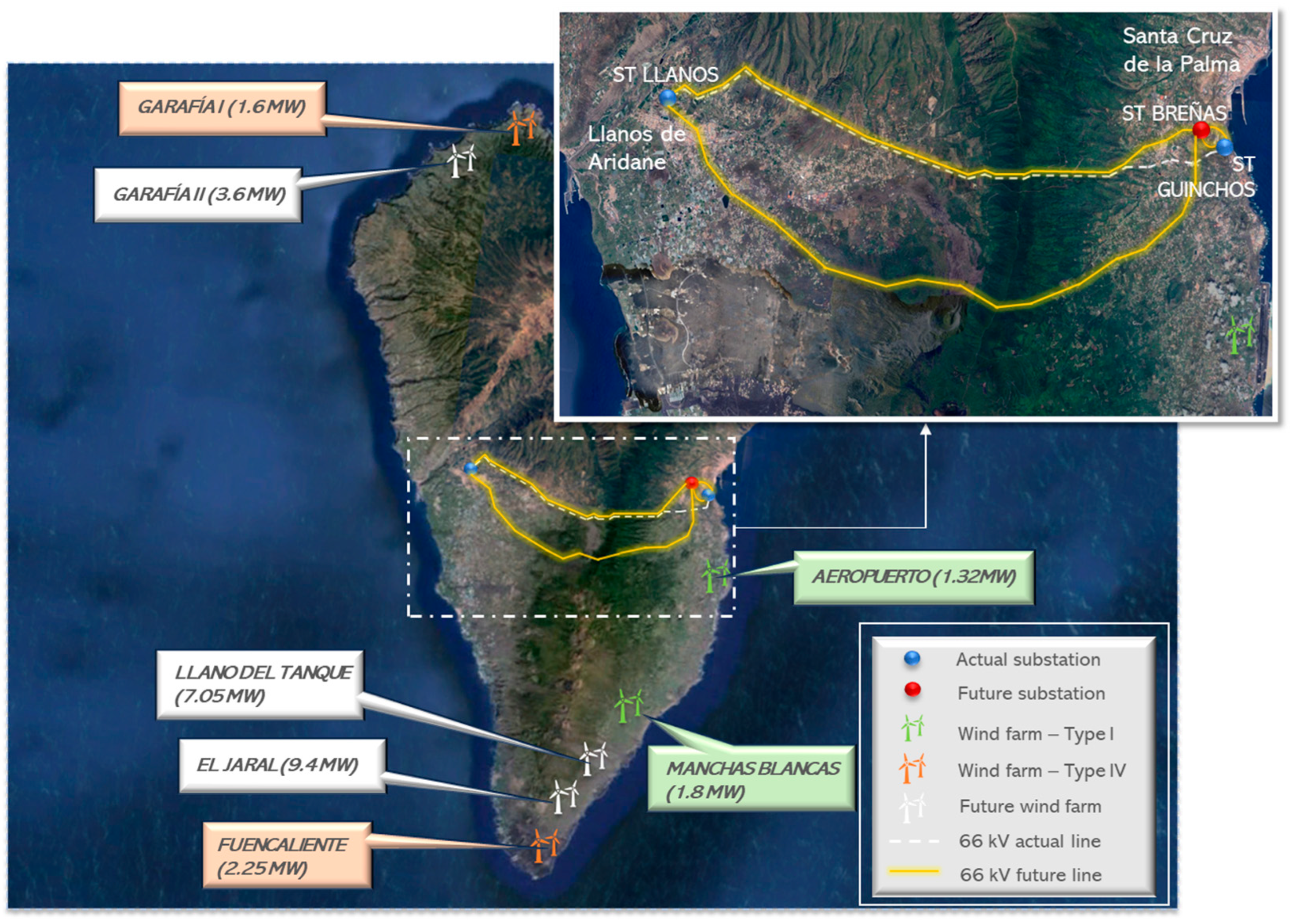


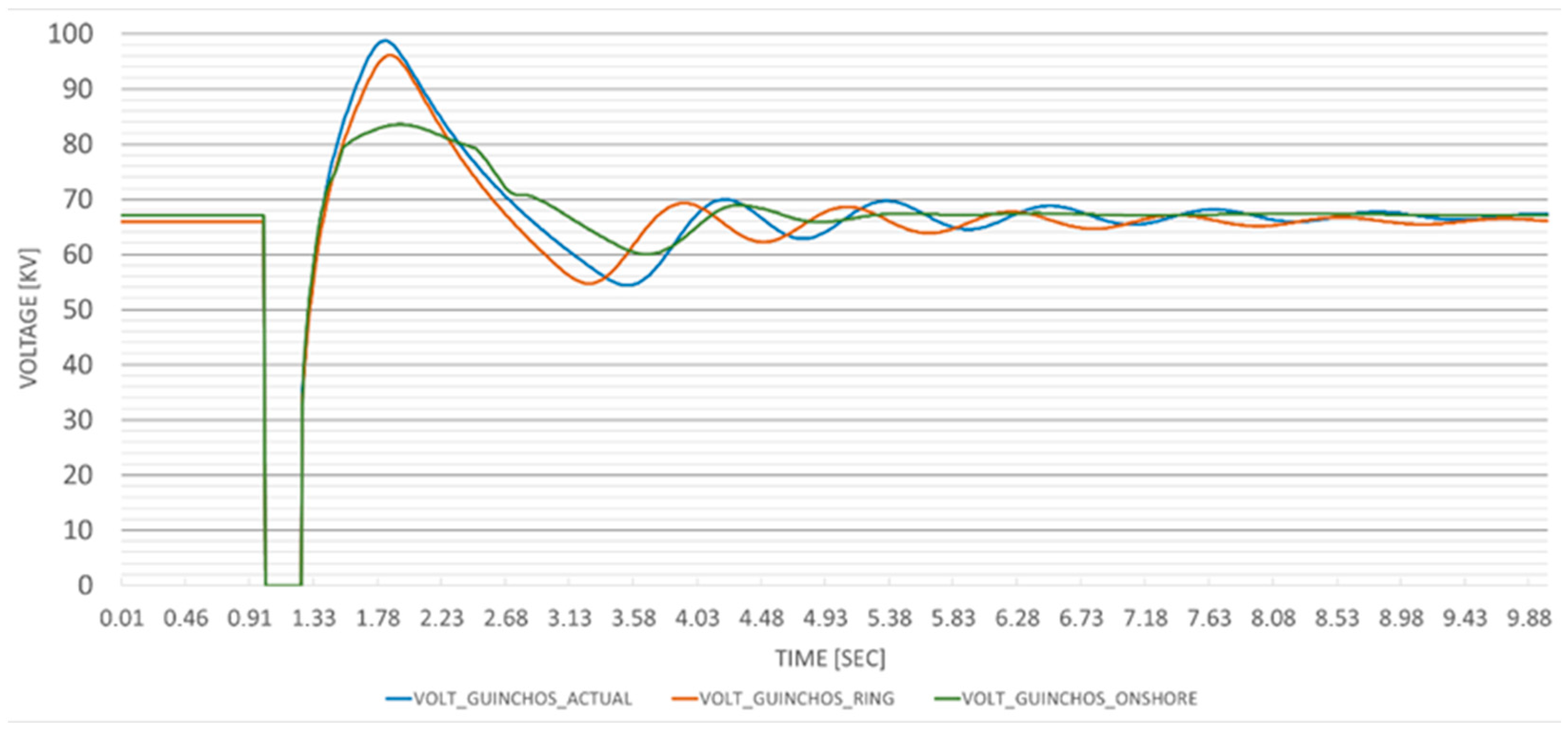

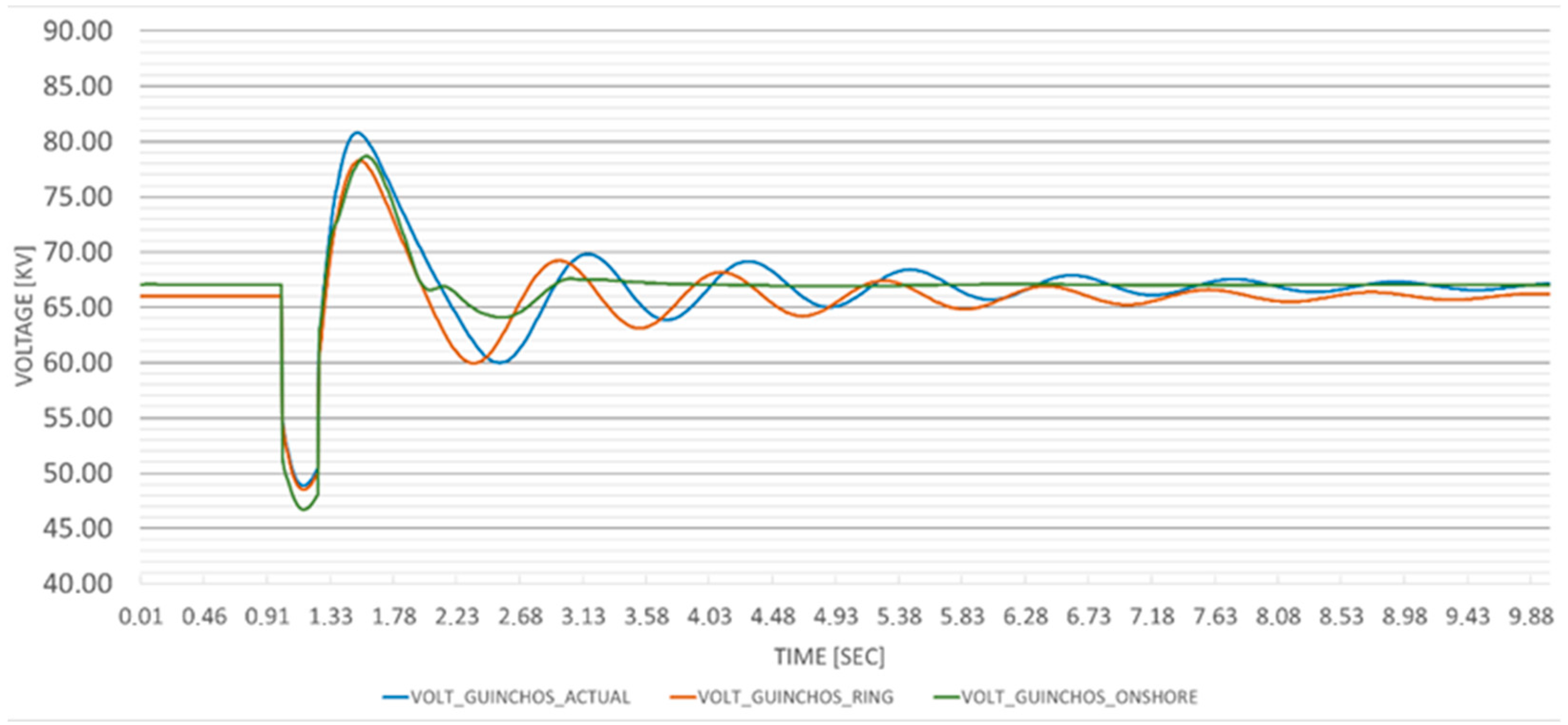
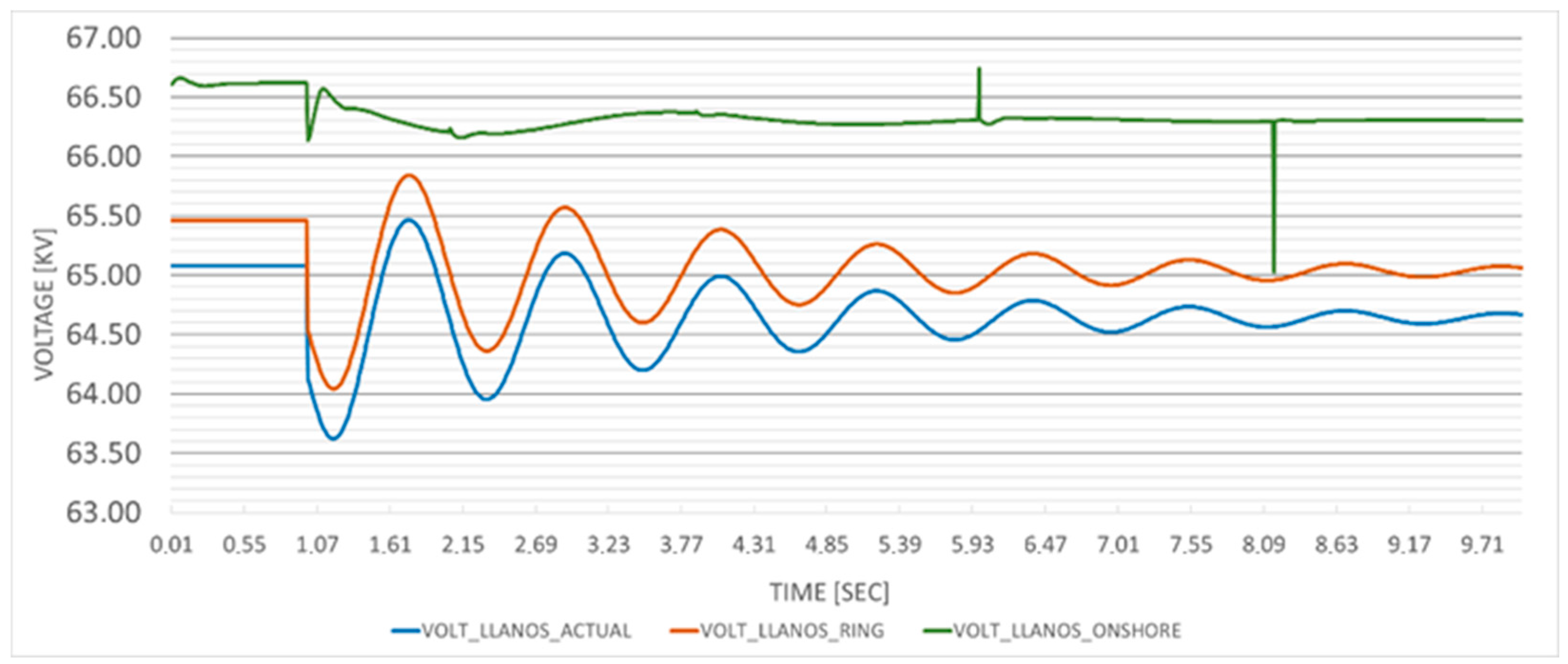
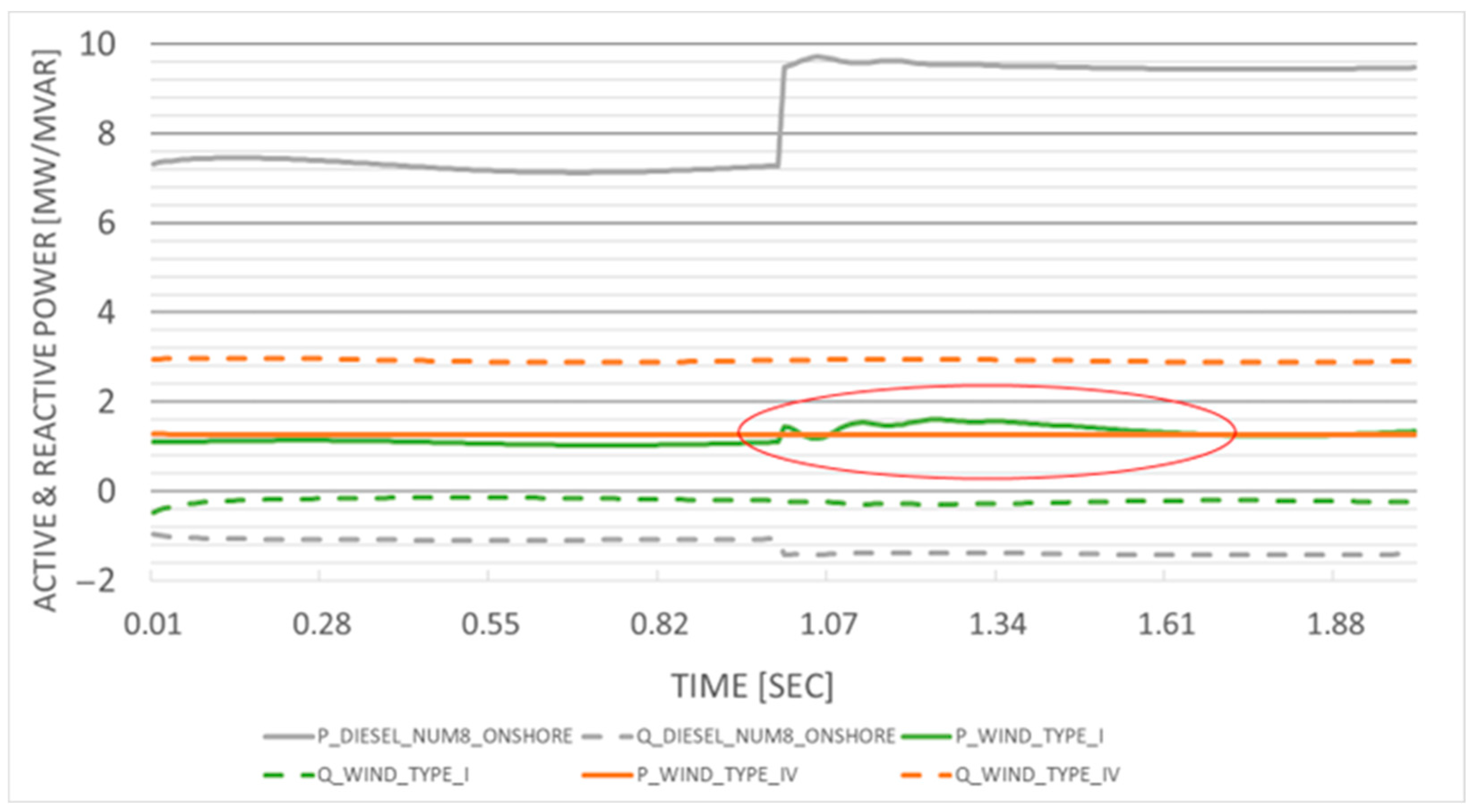
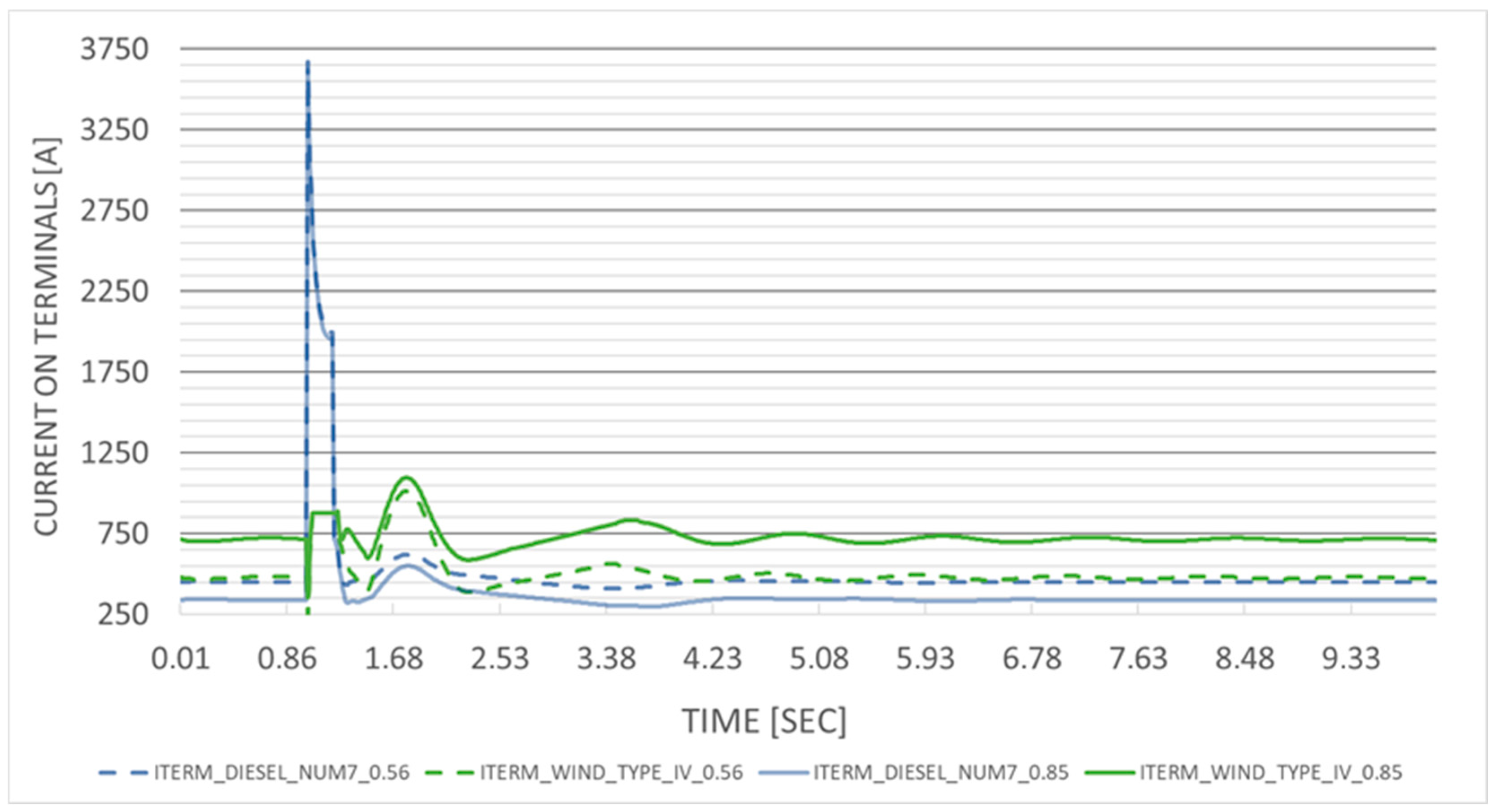
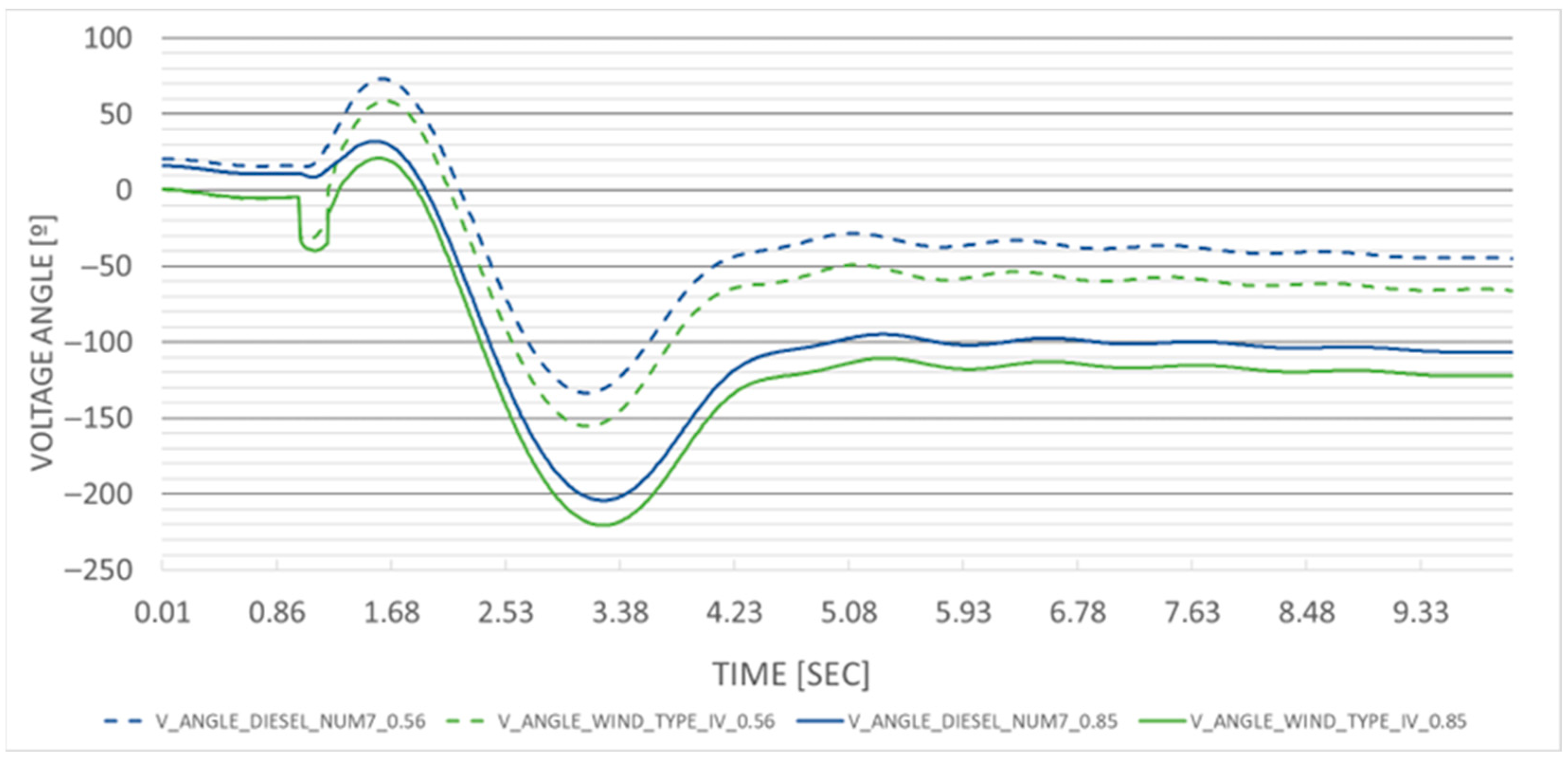
| Reference | Location | Methodology | Key Findings |
|---|---|---|---|
| Gils & Simon (2017) [3] | Canary Islands | Bottom-up modeling using Mesap-PlaNet and REMix tools, with backcasting from a 2050 100% RE target | Local RE potentials suffice to fully meet power, heat and transport demand; sector coupling (EVs, electric heating, synthetic H2) crucial; undersea grid links reduce system costs by ~15% |
| Lemus (2020) [5] | Canary Islands | Technical–strategic analysis | Identifies acceleration of renewables, flexibility, storage and policy alignment as critical enablers for 100% RE in archipelago |
| Connolly & Mathiesen (2014) [6] | Ireland | Techno-economic modeling of 100% RE pathway | Shows achieving 100% renewable share is technically possible and economically viable with integrated planning |
| Katsaprakakis et al. (2009) [7] | Dia, Greece | Simulation based on RES mix | Renewable mix can achieve autonomous electricity supply; storage and intelligent control needed |
| Krajačić et al. (2009) [8] | Mljet, Croatia | H2RES energy planning tool | Tool demonstrates feasibility of high-RE system, including hydrogen storage as firming resource |
| Cabrera et al. (2018) [9] | Gran Canaria, Canary Islands | Smart Energy Systems via EnergyPLAN | Achieved ~75.9% RE supply with current tech; near-100% technically attainable with advanced sector coupling |
| Ramirez-Diaz et al. (2016) [10] | La Palma, Canary Islands | Analysis of EVs + pumped hydro complementarity | EVs and pumped-hydro improve system balance and reduce reliance on thermal backup |
| Padrón et al. (2011) [11] | Gran Canaria, Canary Islands | Pumped storage system case study | PHES increased wind integration and strengthened grid stability |
| Schallenberg-Rodríguez & García (2018) [12] | Canary Islands | Spatial GIS planning for offshore wind potential | Mapped offshore wind zones, estimating their suitability for future development |
| Qiblawey et al. (2022) [13] | Tenerife and Gran Canaria | Techno-economic assessment | Island interconnection decreases CO2 emissions by ~46%, cuts costs and boosts renewable share |
| Magallones & Singh (2023) [14] | Philippines–Sabah | Interconnection impact analysis | Grid links enhance reliability, reduce electricity cost and support higher renewable integration |
| Alves et al. (2019) [15] | Pico and Faial, Azores | Case study of island interconnection | Interconnection allows stabilizing output and increasing renewable penetration |
| Generation Unit Name | Net Capacity [MW] | Minimum Dispatchable Power [MW] [36] |
|---|---|---|
| Thermal Units | 96.44 | |
| Los Guinchos 6, Diésel 6 | 3.82 | 2.35 |
| Los Guinchos 7, Diésel 7 | 3.82 | 2.35 |
| Los Guinchos 8, Diésel 8 | 3.82 | 2.35 |
| Los Guinchos 9, Diésel 9 | 4.3 | 2.82 |
| Los Guinchos 10, Diésel 10 | 6.69 | 4.2 |
| Los Guinchos 12, Diésel 11 | 6.69 | 5.2 |
| Los Guinchos 13, Diésel 12 | 11.5 | 6.63 |
| Los Guinchos 14, Diésel 13 | 11.2 | 6.63 |
| Los Guinchos 15, Gas Móvil 2 | 21.6 | 4.85 |
| Los Guinchos 16, Diésel 14 | 11.5 | 6.63 |
| Los Guinchos 17, Diésel 15 | 11.5 | 6.63 |
| Wind Farms | 6.97 | |
| Garafía-Juan Adalid (2 turbines) | 1.6 | - |
| Fuencaliente (3 turbines) | 2.25 | - |
| Aeropuerto La Palma (2 turbines) | 1.32 | - |
| Manchas Blancas (3 turbines) | 1.8 | - |
| Network | Generation Type | Installed Capacity [MW] | Load Factor | Instantaneous Power [MW] |
|---|---|---|---|---|
| Actual (“a”) and Planned (“b”) | Diesel | 59.08 (3 × 11.5/1 × 11.2/2 × 6.69) | 0.754 | 44.55 |
| Wind | - | - | - | |
| Planned + Wind Gen. (“c”) | Diesel | 45.7 (3 × 11.5/1 × 11.2) | 0.65 | 29.71 |
| Wind | 27.02 (existing + planned) | 0.56 | 15.13 |
| Network | Bus | [kV] | ||
|---|---|---|---|---|
| Actual (“a”) | Guinchos | 66 | 2909.92 | 1422.12 |
| Llanos | 65.08 | 2372.40 | 1217.91 | |
| Planned (“b”) | Guinchos | 66 | 2909.92 | 1422.12 |
| Breñas | 65.98 | 2897.75 | 1417.49 | |
| Llanos | 65.46 | 2570.47 | 1292.23 | |
| Planned + Wind Gen. (“c”) | Guinchos | 66 | 2251.03 | 1588.14 |
| Breñas | 65.99 | 2243.77 | 1585.21 | |
| Llanos | 65.57 | 2043.14 | 1481.92 |
Disclaimer/Publisher’s Note: The statements, opinions and data contained in all publications are solely those of the individual author(s) and contributor(s) and not of MDPI and/or the editor(s). MDPI and/or the editor(s) disclaim responsibility for any injury to people or property resulting from any ideas, methods, instructions or products referred to in the content. |
© 2025 by the authors. Licensee MDPI, Basel, Switzerland. This article is an open access article distributed under the terms and conditions of the Creative Commons Attribution (CC BY) license (https://creativecommons.org/licenses/by/4.0/).
Share and Cite
Peña, R.; Colmenar-Santos, A.; Rosales-Asensio, E. Grid Stability and Wind Energy Integration Analysis on the Transmission Grid Expansion Planned in La Palma (Canary Islands). Processes 2025, 13, 2374. https://doi.org/10.3390/pr13082374
Peña R, Colmenar-Santos A, Rosales-Asensio E. Grid Stability and Wind Energy Integration Analysis on the Transmission Grid Expansion Planned in La Palma (Canary Islands). Processes. 2025; 13(8):2374. https://doi.org/10.3390/pr13082374
Chicago/Turabian StylePeña, Raúl, Antonio Colmenar-Santos, and Enrique Rosales-Asensio. 2025. "Grid Stability and Wind Energy Integration Analysis on the Transmission Grid Expansion Planned in La Palma (Canary Islands)" Processes 13, no. 8: 2374. https://doi.org/10.3390/pr13082374
APA StylePeña, R., Colmenar-Santos, A., & Rosales-Asensio, E. (2025). Grid Stability and Wind Energy Integration Analysis on the Transmission Grid Expansion Planned in La Palma (Canary Islands). Processes, 13(8), 2374. https://doi.org/10.3390/pr13082374










